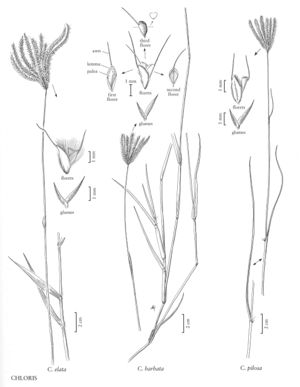Chloris elata
Plants perennial; usually cespitose, rarely stoloniferous. Culms to 135 cm. Sheaths mostly glabrous; ligules 0.7-1 mm, erose to lacerate; blades to 45 cm long, to 15 mm wide, with basal hairs, otherwise usually glabrous, occasionally scabrous. Panicles digitate, with (4)8-28 evidently distinct and easily separable branches; branches (5)8-20 cm, flexible, usually more or less spreading, sometimes drooping, averaging 12 spikelets per cm. Spikelets strongly imbricate, with 1 bisexual and usually 2 sterile florets. Lower glumes 1-2.5 mm; upper glumes 1.9-3.5 mm; lowest lemmas 1.5-2.8 mm long, 0.5-0.9 mm wide, elliptic, strongly laterally compressed, margins conspicuously hairy for most of their length, hairs 1-3 mm, strongly divergent, keels densely appressed pubescent, not or only minutely bilobed, apices awned, awns 1.4-4.8 mm; second florets 1-1.6 mm, cylindrical to narrowly turbinate, shortly bilobed, lobes less than 1/5 as long as the lemmas, awned from the sinuses, awns 1.7-4 mm; third florets often enclosed by the first sterile florets, 0.5-0.9 mm, turbinate or flabellate, as long as or longer than the subtending rachilla segments, sometimes inflated apically, unawned. Caryopses about 1 mm long, about 0.5 mm wide. 2n = 72.
Distribution
Puerto Rico, Pacific Islands (Hawaii), Fla., Tex., Miss.
Discussion
The range of Chloris elata lies primarily to the south of the Flora region, extending from southern Florida and the Caribbean islands to Peru and Argentina.
Selected References
None.
